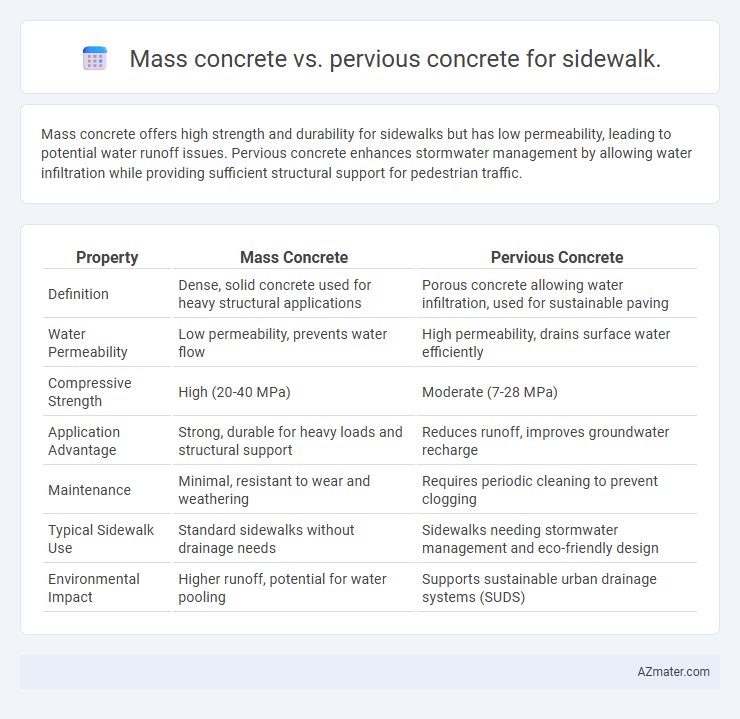Mass concrete offers high strength and durability for sidewalks but has low permeability, leading to potential water runoff issues. Pervious concrete enhances stormwater management by allowing water infiltration while providing sufficient structural support for pedestrian traffic.
Table of Comparison
| Property | Mass Concrete | Pervious Concrete |
|---|---|---|
| Definition | Dense, solid concrete used for heavy structural applications | Porous concrete allowing water infiltration, used for sustainable paving |
| Water Permeability | Low permeability, prevents water flow | High permeability, drains surface water efficiently |
| Compressive Strength | High (20-40 MPa) | Moderate (7-28 MPa) |
| Application Advantage | Strong, durable for heavy loads and structural support | Reduces runoff, improves groundwater recharge |
| Maintenance | Minimal, resistant to wear and weathering | Requires periodic cleaning to prevent clogging |
| Typical Sidewalk Use | Standard sidewalks without drainage needs | Sidewalks needing stormwater management and eco-friendly design |
| Environmental Impact | Higher runoff, potential for water pooling | Supports sustainable urban drainage systems (SUDS) |
Introduction to Mass Concrete and Pervious Concrete
Mass concrete is a dense, solid material commonly used for traditional sidewalk construction, providing high compressive strength and durability to withstand heavy foot traffic and environmental stress. Pervious concrete, designed with interconnected voids, allows water to permeate through the sidewalk surface, enhancing stormwater management and reducing runoff. Selecting between mass concrete and pervious concrete depends on factors such as drainage needs, local climate, and sustainability goals for the sidewalk project.
Key Material Properties
Mass concrete offers high compressive strength and durability due to its dense composition, making it suitable for heavy load-bearing sidewalks. Pervious concrete features a porous structure allowing water permeability, reducing surface runoff and promoting groundwater recharge. The choice between these materials depends on performance requirements, balancing strength in mass concrete with permeability and environmental benefits in pervious concrete.
Structural Performance Comparison
Mass concrete offers superior load-bearing capacity and durability for sidewalks, effectively resisting heavy pedestrian traffic and environmental stressors. Pervious concrete enhances water drainage and reduces runoff but has lower compressive strength and wear resistance compared to mass concrete. The structural performance of mass concrete ensures long-term stability, while pervious concrete requires careful design to balance permeability with mechanical strength.
Permeability and Drainage Capabilities
Pervious concrete offers superior permeability and drainage capabilities compared to mass concrete, allowing rainwater to pass through and reduce surface runoff effectively. Its porous structure supports stormwater management and minimizes water pooling on sidewalks, enhancing safety and environmental benefits. Mass concrete, with low permeability, often requires additional drainage systems to prevent water accumulation and potential structural damage.
Environmental Impact and Sustainability
Mass concrete sidewalks have a higher carbon footprint due to increased cement usage and lower permeability, leading to greater runoff and heat retention. Pervious concrete promotes groundwater recharge by allowing water to pass through, reducing stormwater runoff and mitigating urban heat island effects. Incorporating pervious concrete enhances sustainability by supporting natural water cycles and decreasing environmental pollution.
Installation Techniques and Workability
Mass concrete for sidewalks requires extensive formwork and careful curing to control heat generation and shrinkage, demanding skilled labor and longer installation times. Pervious concrete emphasizes rapid placement and minimal finishing to maintain permeability, necessitating specialized mix designs with larger aggregate sizes and reduced fines for optimal water infiltration. Workability of mass concrete is higher with traditional slump values, while pervious concrete exhibits lower slump and a stiffer mix, requiring precise handling to prevent clogging and ensure structural integrity.
Durability and Maintenance Requirements
Mass concrete sidewalks offer superior durability with high compressive strength and resistance to heavy loads, making them suitable for areas with frequent foot traffic and harsh weather conditions. Pervious concrete provides excellent drainage and reduces surface water buildup, but its porous nature may require more frequent maintenance to prevent clogging and maintain permeability. While mass concrete demands less routine upkeep due to its dense composition, pervious concrete necessitates regular cleaning to sustain both structural integrity and effective water flow.
Cost Efficiency and Lifecycle Analysis
Mass concrete sidewalks offer lower initial costs due to simpler materials and installation processes, but they require more extensive maintenance over time because of poor water drainage. Pervious concrete, although involving higher upfront investment for specialized materials and labor, enhances cost efficiency through reduced stormwater management expenses and extended pavement lifespan by preventing water damage. Lifecycle analysis demonstrates that pervious concrete provides superior long-term economic benefits by decreasing maintenance frequency and mitigating environmental impact.
Suitability for Urban Sidewalk Applications
Mass concrete offers high strength and durability, making it suitable for urban sidewalks with heavy pedestrian traffic and occasional vehicular loads. Pervious concrete provides excellent stormwater management by allowing water to infiltrate, reducing runoff and urban flooding in densely populated areas. Urban sidewalks benefit from selecting concrete types based on load requirements and environmental sustainability goals.
Summary: Choosing the Best Concrete for Sidewalks
Mass concrete offers high durability and strength, making it ideal for heavy-traffic sidewalks requiring long-term stability. Pervious concrete enhances drainage and reduces surface runoff, promoting environmental sustainability and reducing puddling on pedestrian paths. Selecting between mass and pervious concrete depends on traffic load, drainage needs, and environmental impact considerations for optimal sidewalk performance.

Infographic: Mass concrete vs Pervious concrete for Sidewalk
 azmater.com
azmater.com